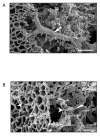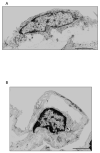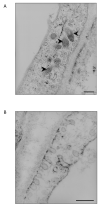New developments in lung endothelial heterogeneity: Von Willebrand factor, P-selectin, and the Weibel-Palade body
- PMID: 20490980
- PMCID: PMC2917989
- DOI: 10.1055/s-0030-1253452
New developments in lung endothelial heterogeneity: Von Willebrand factor, P-selectin, and the Weibel-Palade body
Abstract
Quiescent pulmonary endothelium establishes an antithrombotic, anti-inflammatory surface that promotes blood flow. However, the endothelium rapidly responds to injury and inflammation by promoting thrombosis and enabling the directed transmigration of inflammatory cells, such as neutrophils, into the alveolar airspace. Although the endothelial cell signals responsible for establishing a prothrombotic surface are distinct from those responsible for recognizing circulating neutrophils, these processes are highly interrelated. Von Willebrand factor (VWF)-stimulated secretion plays an important role in thrombus formation, and P-selectin surface expression plays a key role in neutrophil binding necessary for transmigration. Both VWF and P-selectin are located within Weibel-Palade bodies in pulmonary arteries and arterioles, yet Weibel-Palade bodies are absent in capillaries. Despite the absence of the Weibel-Palade bodies, pulmonary capillaries express both VWF and P-selectin. The physiological and pathophysiological significance of these observations is unclear. In this review, we address some anatomical and physiological features that distinguish pulmonary artery, capillary, and vein endothelium. In addition, we review our current understanding regarding the stimulated secretion of VWF and P-selectin in pulmonary artery and capillary endothelium. This information is considered in the context of vasculitis and pneumonia, two pathophysiological processes to which the stimulated secretion of VWF and P-selectin contribute.
Thieme Medical Publishers.
Figures




References
-
- Stan RV. Anatomy of the pulmonary endothelium. In: Voelkel NF, Rounds S, editors. The Pulmonary Endothelium. Wiley-Blackwell; West Sussex, UK: 2009. p. 25.
-
- King J. Structural and functional characteristics of lung macro- and microvascular endothelial cell phenotypes. Microvascular Research. 2004;67(2):139–151. - PubMed
-
- Stevens T, Fouty B, Hepler L, et al. Cytosolic Ca2+ and adenylyl cyclase responses in phenotypically distinct pulmonary endothelial cells. Am J Physiol. 1997;272(1 Pt 1):L51–9. - PubMed
-
- Stevens T, Creighton J, Thompson WJ. Control of cAMP in lung endothelial cell phenotypes. implications for control of barrier function. Am J Physiol. 1999;277(1 Pt 1):L119–26. - PubMed
Publication types
MeSH terms
Substances
Grants and funding
LinkOut - more resources
Full Text Sources
Miscellaneous

